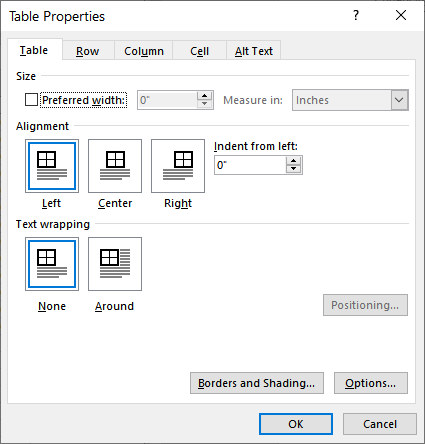Please Note: This article is written for users of the following Microsoft Word versions: 2007, 2010, 2013, 2016, 2019, and 2021. If you are using an earlier version (Word 2003 or earlier), this tip may not work for you. For a version of this tip written specifically for earlier versions of Word, click here: Quickly Accessing the Column Tab.
Written by Allen Wyatt (last updated August 15, 2020)
This tip applies to Word 2007, 2010, 2013, 2016, 2019, and 2021
There are many ways you can adjust column width and other table settings. For precise adjustment of column width, you might want to access the Table Properties dialog box. You can do this quickly in the following manner:
There is also an alternative way to access the same dialog box, and you may find it easier to use. You can follow these steps:

Figure 1. The Table Properties dialog box.
WordTips is your source for cost-effective Microsoft Word training. (Microsoft Word is the most popular word processing software in the world.) This tip (13311) applies to Microsoft Word 2007, 2010, 2013, 2016, 2019, and 2021. You can find a version of this tip for the older menu interface of Word here: Quickly Accessing the Column Tab.

Create Custom Apps with VBA! Discover how to extend the capabilities of Office 365 applications with VBA programming. Written in clear terms and understandable language, the book includes systematic tutorials and contains both intermediate and advanced content for experienced VB developers. Designed to be comprehensive, the book addresses not just one Office application, but the entire Office suite. Check out Mastering VBA for Microsoft Office 365 today!
For those times when you remove the borders from your tables, Word provides a way that you can display non-printing ...
Discover MoreNeed to jump from one end of a table row to another? Word provides a couple of handy shortcuts that can make this type of ...
Discover MoreCan you put a numbered outline in a table? Yes, you can. But Word is rather prickly when it comes to using the keyboard ...
Discover MoreFREE SERVICE: Get tips like this every week in WordTips, a free productivity newsletter. Enter your address and click "Subscribe."
There are currently no comments for this tip. (Be the first to leave your comment—just use the simple form above!)
Got a version of Word that uses the ribbon interface (Word 2007 or later)? This site is for you! If you use an earlier version of Word, visit our WordTips site focusing on the menu interface.
Visit the WordTips channel on YouTube
FREE SERVICE: Get tips like this every week in WordTips, a free productivity newsletter. Enter your address and click "Subscribe."
Copyright © 2026 Sharon Parq Associates, Inc.
Comments